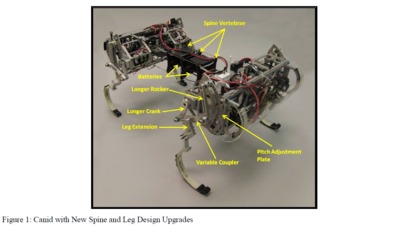
We document initial experiments with Canid, a freestanding, power-autonomous quadrupedal robot equipped with a parallel actuated elastic spine. Research into robotic bounding and galloping platforms holds scientific and engineering interest because it can both probe biological hypotheses regarding bounding and galloping mammals and also provide the engineering community with a new class of agile, efficient and rapidly-locomoting legged robots. We detail the design features of Canid that promote our goals of agile operation in a relatively cheap, conventionally prototyped, commercial off-the-shelf actuated platform. We introduce new measurement methodology aimed at capturing our robot’s “body energy” during real time operation as a means of quantifying its potential for agile behavior. Finally, we present joint motor, inertial and motion capture data taken from Canid’s initial leaps into highly energetic regimes exhibiting large accelerations that illustrate the use of this measure and suggest its future potential as a platform for developing efficient, stable, hence useful bounding gaits.
For more information: Kod*Lab

